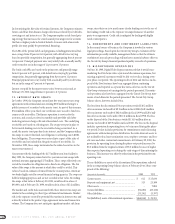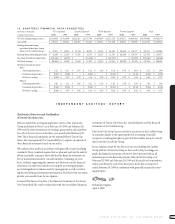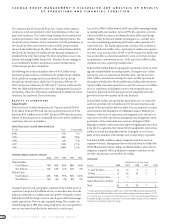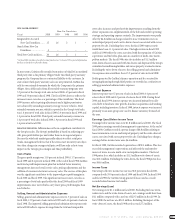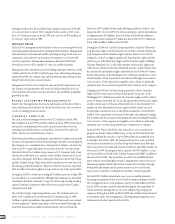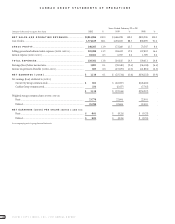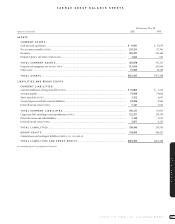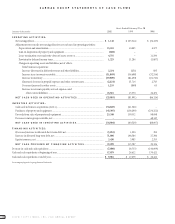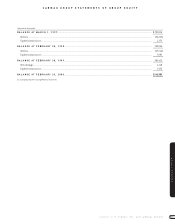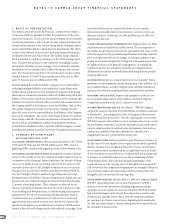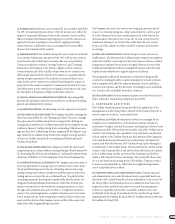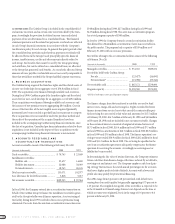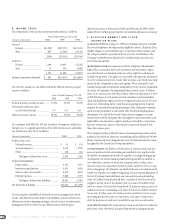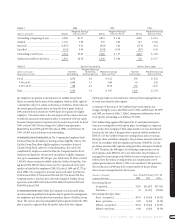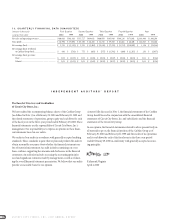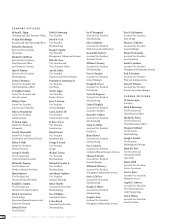CarMax 2000 Annual Report Download - page 74
Download and view the complete annual report
Please find page 74 of the 2000 CarMax annual report below. You can navigate through the pages in the report by either clicking on the pages listed below, or by using the keyword search tool below to find specific information within the annual report.
NOTES TO CARMAX GROUP FINANCIAL STATEMENTS
CIRCUIT CITY STORES, INC. 2000 ANNUAL REPORT
72
1. BASIS OF PRESENTATION
The common stock of Circuit City Stores,Inc.consists of two common
stock series,which are intended to reflect the performance of the Com-
pany’s two businesses. The Circuit City Group Common Stock is intended
to track the performance of the Circuit City store-related operations,the
Group’s retained interest in the CarMax Group and the Company’s invest-
ment in Digital Video Express,which has been discontinued. The effects
of this retained interest on the Circuit City Group’s financial statements
are identified by the term “Inter-Group.”The CarMax Group Common
Stock is intended to track the performance of the CarMax Group’s opera-
tions. The Inter-Group Interest is not considered outstanding CarMax
Group Stock. Therefore,any net earnings or loss attributed to the Inter-
Group Interest is not included in the CarMax Group’s per share calcula-
tions. The Circuit City Group held a 74.7 percent interest in the CarMax
Group at February 29,2000,76.6 percent interest at February 28, 1999,
and a 77.3 percent interest at February 28, 1998.
Notwithstanding the attribution of the Company’s assets and liabilities,
including contingent liabilities,and stockholders’equity between the
CarMax Group and the Circuit City Group for the purposes of preparing
their respective financial statements,holders of CarMax Group Stock and
holders of Circuit City Group Stock are shareholders of the Company and
continue to be subject to all of the risks associated with an investment in
the Company and all of its businesses,assets and liabilities. Such attribu-
tion and the change in the equity structure of the Company does not
affect title to the assets or responsibility for the liabilities of the Company
or any of its subsidiaries. The results of operations or financial condition
of one Group could affect the results of operations or financial condition of
the other Group. Accordingly, the CarMax Group financial statements
included herein should be read in conjunction with the Company’s consoli-
dated financial statements and the Circuit City Group financial statements.
2. SUMMARY OF SIGNIFICANT
ACCOUNTING POLICIES
(A) CASH AND CASH EQUIVALENTS: Allocated cash equivalents of $1,770,000
at February 29, 2000, and $14,750,000 at February 28,1999,consist of
highly liquid debt securities with original maturities of three months or less.
(B) TRANSFERS AND SERVICING OF FINANCIAL ASSETS: For transfers of finan-
cial assets that qualify as sales, the Company recognizes gains or losses as
a component of the Company’s finance operations. For transfers of finan-
cial assets to qualify for sale accounting, control over the assets must be
surrendered at the time of sale. Multiple estimates are used to calculate
the gain or loss on sales of receivables under the provisions of SFAS No.
125,“Accounting for Transfers and Servicing of Financial Assets and
Extinguishments of Liabilities.”Finance charge income,default rates and
payment rates are estimated using projections developed from the prior
12 months of operating history. These estimates are adjusted for any
industry or portfolio trends that have been observed. The present value
of the resulting cash flow projections is calculated using a discount rate
appropriate for the type of asset and risk. Retained interests (such as
residual interests in a securitization trust,cash reserve accounts and
rights to future interest from serviced assets that exceed contractually
specified servicing fees) are included in net accounts receivable and are
carried at fair value with changes in fair value reflected in earnings. Loan
receivables held for sale are carried at the lower of cost or market,
whereas loan receivables held for investment are carried at cost less an
allowance for losses. At February 29,2000,and February 28, 1999, cost
approximates fair value.
(C) FAIR VALUE OF FINANCIAL INSTRUMENTS: The Company enters into finan-
cial instruments on behalf of the CarMax Group. The carrying value of
the CarMax Group’s financial instruments approximates fair value. Credit
risk is the exposure to the potential nonperformance of another material
party to an agreement because of changes in economic, industry or geo-
graphic factors and is mitigated by dealing only with counterparties that
are highly rated by several financial rating agencies. Accordingly, the
CarMax Group does not anticipate material loss for nonperformance.
All financial instruments are broadly diversified along industry, product
and geographic areas.
(D) INVENTORY: Inventory is stated at the lower of cost or market. Vehicle
inventory cost is determined by specific identification. Parts and labor used
to recondition vehicles,as well as transportation and other incremental
expenses associated with acquiring vehicles,are included in inventory.
(E) PROPERTY AND EQUIPMENT: Property and equipment is stated at cost
less accumulated depreciation. Depreciation is calculated using the
straight-line method over the assets’ estimated useful lives.
(F) COMPUTER SOFTWARE COSTS: Effective March 1,1998,the Company
adopted the American Institute of Certified Public Accountants Statement
of Position 98-1,“Accounting for the Costs of Computer Software Devel-
oped or Obtained for Internal Use.”Once the capitalization criteria of the
SOP have been met,external direct costs of materials and services used in
the development of internal-use software and payroll and payroll-related
costs for employees directly involved in the development of internal-use
software are capitalized. Amounts capitalized are amortized on a
straight-line basis over a period of three to five years.
(G) INTANGIBLE ASSETS: Amounts paid for acquired businesses in excess of
the fair value of the net tangible assets acquired are recorded as goodwill,
which is amortized on a straight-line basis over 15 years,and covenants
not to compete,which are amortized on a straight-line basis over the life
of the covenant not to exceed five years. Both goodwill and covenants not
to compete are included in other assets on the accompanying CarMax
Group balance sheets. Based upon the financial performance of the
acquired businesses,the carrying values of intangible assets are periodi-
cally reviewed by the Company and impairments are recognized when the
expected future undiscounted operating cash flows derived from such
intangible assets are less than the carrying values.
(H) PRE-OPENING EXPENSES: Effective March 1,1999,the Company adopted
SOP 98-5,“Reporting on the Costs of Start-Up Activities.”SOP 98-5
requires costs of start-up activities, including organization and pre-
opening costs, to be expensed as incurred. Adoption of SOP 98-5 did not
have a material impact on the Group’s financial position,annual results
of operation or liquidity. Prior to fiscal 2000,the Company capitalized
pre-opening costs for new store locations. Beginning in the month after
the store opened for business,the pre-opening costs were amortized over
the remainder of the fiscal year.


